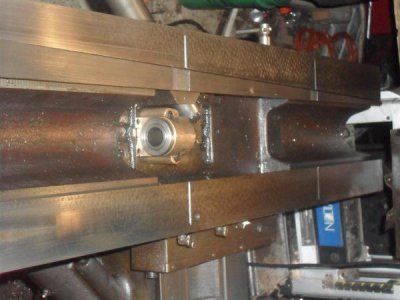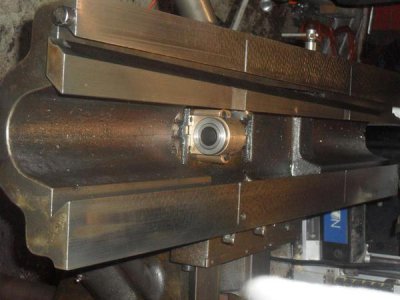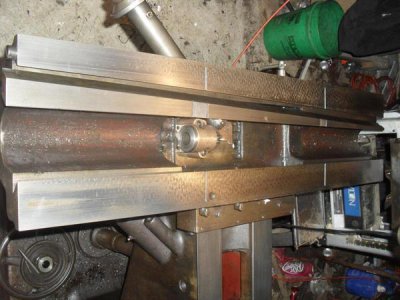- Joined
- Jul 1, 2012
- Messages
- 1,356
The way I scrape the gib is different then Nick. First thing I do is file the ends as they usually have a burr or raised from when the the gib bolt is over tightened. Then I check the gib to see if it is flat by laying the back unworn side on a surface plate, they are usually high in the middle because it wears on the other side. I measure it with a feeler gage It's the same thing when you mill or grind a thin piece of steel on one side it bends. After I discover how much it's bent I flatten the gib in a few different ways, I hope Tadd or Bill one of the other students who took a class can supply a picture here as I don't have one.
But I bend it by normally by laying the gib back side up on 2 wood blocks on the ends and press down with my hand or use a c-clamp taking a small amount at a time. I sometimes will set a mag base behind it and put a 1" travel plunger indicator on the gib and tight the clamp then loosen it until It's straight. You will be surprised as to how much you can bend the gib and it won't break. In the classes I shown how I can bend a Bridgeport gib a 1/4" just to show how they don't break.
With that said on some of these small Chinese machines be careful bending them as some of the iron is very brittle. Then I blue up the back of the gib and scrape it so it has 2 - 5 PPI and 60% coverage POP. One thing you have to do is to check the surface the back side of the gib rests on. That surface is sometimes high in the middle and the ends have burrs. This should also be tested with a blued straight edge and be sure it is flat by checking the airy points or 30% hinge from both ends. Be sure to pull the gib up off the bottom of the dovetail or the hinge will look like it's on the ends.
I don't hammer in the gib like Nick does, I put the gib in and slide the side back and forth and check the taper so both ends are the same using a mag base in indicator as seen in the picture below. Tou have to have some slop in the test, say .003" on the tight end. So if you push pull the part on the one end and you get .004" and move the indicator to the other and and do the push pull and you get .006" the gibs taper is off .002" and needs to be stepped scraped. When it gets close I being finished I put the gib screws in to hold it. I seldom buy a new gib because it slides in to far as the gibs you buy will have to be scraped.
I just saw where a company I do work for (now) bought some new gibs for a centerless grinder because the old gibs were out of adjustment expecting them to fit. The taper was off .015" and the work head wiggled and the machine crashed. So don't assume the new gib will work. My cure for a worn gib is to glue on a Phenolic shim on the back side or glue on Rulon on the front side and scrape it. Scrape it and when I am done I relieve the middle 40% of the gib approx .0005 low", so when the gib wears it wears flatter.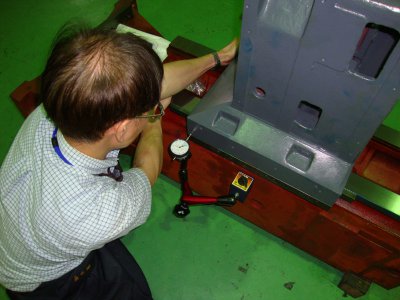
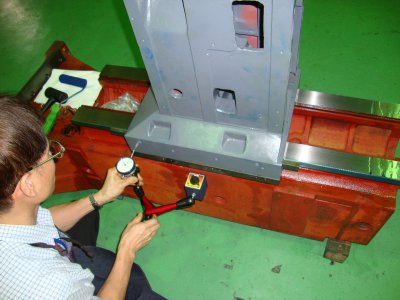
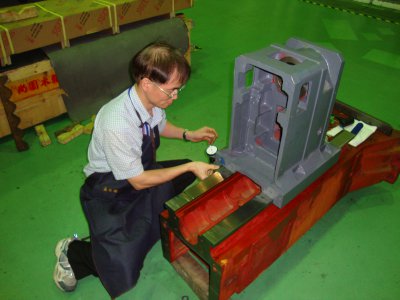 Using the Rulon makes the slide tighter and it slides like butter. I would say 90% of all machine built today has either Rulon, Turcite, some other brand of Teflon / bronze filled wear strip on them. I have no clue of the percentage machines coming out of China with it. From the hand full of ones I have seen they are cast iron and in rough shape.
Using the Rulon makes the slide tighter and it slides like butter. I would say 90% of all machine built today has either Rulon, Turcite, some other brand of Teflon / bronze filled wear strip on them. I have no clue of the percentage machines coming out of China with it. From the hand full of ones I have seen they are cast iron and in rough shape.
I need to scoot, working on a grinder this week More later. If any one else can add to this please join it. Rich



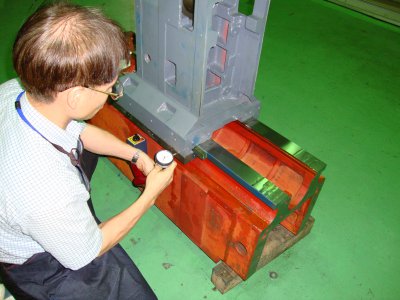
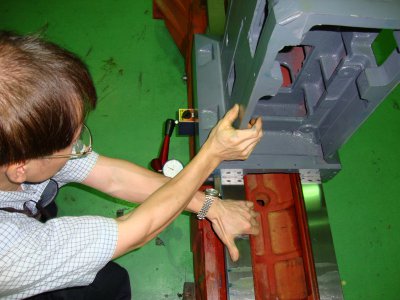
But I bend it by normally by laying the gib back side up on 2 wood blocks on the ends and press down with my hand or use a c-clamp taking a small amount at a time. I sometimes will set a mag base behind it and put a 1" travel plunger indicator on the gib and tight the clamp then loosen it until It's straight. You will be surprised as to how much you can bend the gib and it won't break. In the classes I shown how I can bend a Bridgeport gib a 1/4" just to show how they don't break.
With that said on some of these small Chinese machines be careful bending them as some of the iron is very brittle. Then I blue up the back of the gib and scrape it so it has 2 - 5 PPI and 60% coverage POP. One thing you have to do is to check the surface the back side of the gib rests on. That surface is sometimes high in the middle and the ends have burrs. This should also be tested with a blued straight edge and be sure it is flat by checking the airy points or 30% hinge from both ends. Be sure to pull the gib up off the bottom of the dovetail or the hinge will look like it's on the ends.
I don't hammer in the gib like Nick does, I put the gib in and slide the side back and forth and check the taper so both ends are the same using a mag base in indicator as seen in the picture below. Tou have to have some slop in the test, say .003" on the tight end. So if you push pull the part on the one end and you get .004" and move the indicator to the other and and do the push pull and you get .006" the gibs taper is off .002" and needs to be stepped scraped. When it gets close I being finished I put the gib screws in to hold it. I seldom buy a new gib because it slides in to far as the gibs you buy will have to be scraped.
I just saw where a company I do work for (now) bought some new gibs for a centerless grinder because the old gibs were out of adjustment expecting them to fit. The taper was off .015" and the work head wiggled and the machine crashed. So don't assume the new gib will work. My cure for a worn gib is to glue on a Phenolic shim on the back side or glue on Rulon on the front side and scrape it. Scrape it and when I am done I relieve the middle 40% of the gib approx .0005 low", so when the gib wears it wears flatter.


 Using the Rulon makes the slide tighter and it slides like butter. I would say 90% of all machine built today has either Rulon, Turcite, some other brand of Teflon / bronze filled wear strip on them. I have no clue of the percentage machines coming out of China with it. From the hand full of ones I have seen they are cast iron and in rough shape.
Using the Rulon makes the slide tighter and it slides like butter. I would say 90% of all machine built today has either Rulon, Turcite, some other brand of Teflon / bronze filled wear strip on them. I have no clue of the percentage machines coming out of China with it. From the hand full of ones I have seen they are cast iron and in rough shape.I need to scoot, working on a grinder this week More later. If any one else can add to this please join it. Rich







